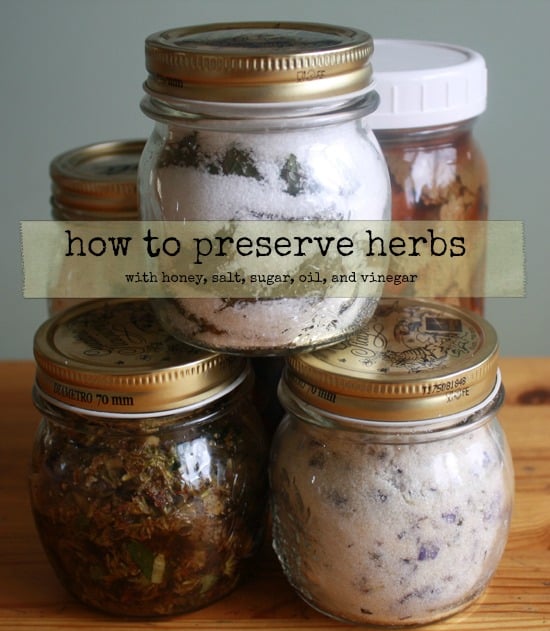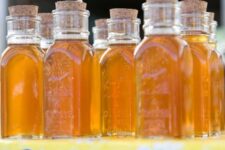
As the summer begins to draw to a close, I still have a lot of beautiful herbs in my garden. I can’t possibly use them all in recipes before they become casualties of the first frost.
Yes, I could freeze some, and yes, I could tie some in bunches and hang them to dry. I will be using these methods with some of my herbs, but I thought I’d share some of the other ways I’m preserving herbs this year.
Preserving Herbs in Oil*
Here is an herbal oil I made with calendula (marigold) flowers (I used about 8 in this small 8 oz. jar), the peeled cloves from 1 head of garlic, 1-2 handfuls of fresh basil, and a small hot pepper (omit if you don’t want your herbal oil to be spicy) steeped in olive oil. I love this oil and have made it many times before; sometimes I also add a few sun-dried tomatoes.

To reduce the risk of any mold forming in your oil, make sure your glass jar is very dry before you fill it with your herbs. The herbs you use also need to be very dry: moisture makes it more likely that mold will form. It is also important to make sure your herbs are completely covered by the oil; if not, some mold may form on any herb(s) exposed at the top. If you open your jar and notice that this has happened, discard the top layer of herbs and top off with a little more oil.
Allow to sit for up to 6 week to infuse. After this time, strain out the herbs and transfer your oil to a clean, dry jar. Herbal oils are wonderful in salad dressings, as well as drizzled over pasta, grains or veggies.
*Please note that according to the National Center for Home Food Preservation, “Herbs and oils are both low-acid and together could support the growth of the disease-causing Clostridium botulinum bacteria. Oils may be flavored with herbs if they are made up for fresh use, stored in the refrigerator and used within 2 to 3 days. Fresh herbs must be washed well and dried completely before storing in the oil.” I personally have never had a problem preserving herbs in oil the way I described above, but it’s important to keep this warning in mind…Clostridium botulinum is nothing to food around with!
Preserving Herbs in Vinegar
I also love preserving herbs in vinegar and I make several batches of herbal vinegars every summer. Here is a strawberry lemon balm vinegar I made several weeks ago. To make it, I combined 2 cups of clean, dry, organic strawberries from my garden with 2 cups of lemon balm leaves in a 1 quart jar, and then filled the jar with apple cider vinegar (I use organic unpasteurized apple cider vinegar, but any kind will do).

Besides being easy to prepare and surprisingly tasty, herbal vinegars are also quite nutritious because vinegar extracts minerals, including calcium, magnesium and iron, from the plants you use to make your preparation.
When you make herbal vinegar, there is pretty much no chance of contamination: vinegar is a great preservative and the acidity keeps out any potentially dangerous bacteria. I like to use plastic lids when making herbal vinegars (vinegar can eat away at the underside of the metal ones); if you don’t have a plastic lid, just put a piece of plastic wrap under your metal lid before screwing it on.
After giving your herbal vinegar 4-6 weeks to chill out in a dark place, strain out the herbs (and whatever else you’ve used in there: in this case strawberries- you can eat them but I am not sure you’d want to!) and pour the vinegar back into a glass jar where it will keep pretty much indefinitely (or at least for a year or two). Use anywhere you would use vinegar: in dressings, over cooked greens, etc.
Preserving Herbs in Sugar
I learned about making herbal sugars from Nigella Lawson’s book: How to Be a Domestic Goddess. I have kept rosemary sugar in my cupboard for years: I like to add a teaspoon or so to batches of homemade tomato sauce as well as meat stews. I recently made some with basil in addition to rosemary and I plan to use it the same way.

Other herbs that can be used to make herbal sugars are mint, thyme and sage, as well as lavender. Adding a vanilla bean to a jar of sugar is also a great idea (though I doubt very much you have vanilla beans in your garden). For a subtle herbal touch, you can add just a few sprigs of your preferred herb to a jar containing 2-4 cups of (preferably organic) sugar. Or, if you are looking for more herbal flavor, you can use more of the herbs and bruise and chop them before adding to the sugar. These sugars last for a long time, especially if you are like me and you don’t use sugar all that much.
Sugars made with sweet herbs and edible flowers are also lovely- here is a sugar I made from finely chopped lavender leaves. Like a vanilla sugar, I think it will be nice in tea, or perhaps I will use it to flavor winter porridge or mix it into plain yogurt.

Preserving Herbs in Honey
Honey is a another wonderful preservative and is great for making tasty preparations that can be used in cooking or as medicines. I keep a large jar of garlic cloves infused in honey in my refrigerator all winter long- when I’m feeling like a cold is coming on, I try eat a clove every hour until I’m feeling better.

I also like to preserve herbs such as lemon balm and anise hyssop in honey. Above you see an herbal honey that I made by combining these two herbs with some ginger. To make it, I chopped all the herbs fine, placed them in my jar, and then filled it to the top with honey (I prefer to use honey that is raw and local, but any kind is fine). Like the other herbal preparations, you should allow your herbal honey to infuse for 6 weeks or more before you use it. Herbal honeys can be used for their yummy flavor on toast, in tea, or they can be taken by the spoonful as medicines for sore throat and other ailments.
Preserving Herbs in Salt
This method is new for me this year, and I am trying it with shiso leaves and basil. Doing this is very simple: you just make alternating layers in a jar of herbs and coarse salt. Put a thicker layer of salt on the bottom of your jar and at the top, but between each layer of herbs, you just need enough to cover the leaves of the herbs you are using. I’m going to store my jars of salt preserved herbs in the refrigerator, and I plan to use both the herbs and the salt in recipes.

I imagine that after the herbs have infused in the salt for a while, you could also pulverize them together and use as a seasoning. This is true of the herbal sugars, as well: feel free to blend them up to make sprinkling into recipes easier.
Next week I’ll talk about preserving fruits…so stay tuned!






